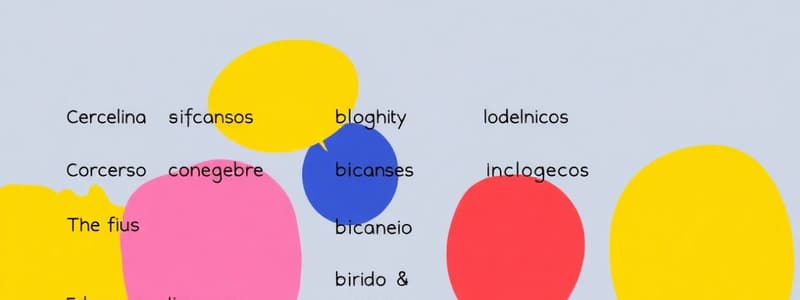Podcast
Questions and Answers
Which of the following is an example of a regular -ar verb?
Which of the following is an example of a regular -ar verb?
- tener
- ser
- ir
- hablar (correct)
What is the correct conjugation for the first-person singular of the verb 'comer' in the present tense?
What is the correct conjugation for the first-person singular of the verb 'comer' in the present tense?
- comes
- comen
- comemos
- como (correct)
Which verb represents an irregular future tense conjugation?
Which verb represents an irregular future tense conjugation?
- tenderé (correct)
- comeré
- viviré
- hablaré
In Spanish, what is the plural form of the noun 'la casa'?
In Spanish, what is the plural form of the noun 'la casa'?
Which of the following sentences correctly follows the subject-verb-object structure?
Which of the following sentences correctly follows the subject-verb-object structure?
What is the correct definite article for the masculine singular noun 'libro'?
What is the correct definite article for the masculine singular noun 'libro'?
Which of the following phrases means 'I am hungry'?
Which of the following phrases means 'I am hungry'?
Which of these adjectives is correctly agreeing with a plural noun?
Which of these adjectives is correctly agreeing with a plural noun?
What is the conjugation of the verb 'estar' for 'ellos' in the present tense?
What is the conjugation of the verb 'estar' for 'ellos' in the present tense?
What is the infinitive form of 'tendré'?
What is the infinitive form of 'tendré'?
Flashcards are hidden until you start studying
Study Notes
Conjugation
- Regular Verbs:
- -ar, -er, -ir endings
- Example: hablar (to speak), comer (to eat), vivir (to live)
- -ar, -er, -ir endings
- Irregular Verbs:
- Common examples include ser (to be), estar (to be), ir (to go)
- Present Tense:
- -ar: o, as, a, amos, áis, an
- -er: o, es, e, emos, éis, en
- -ir: o, es, e, imos, ís, en
- Past Tense (Preterite):
- -ar: é, aste, ó, amos, asteis, aron
- -er/-ir: í, iste, ió, imos, isteis, ieron
- Future Tense:
- Regular: infinitive + é, ás, á, emos, éis, án
- Irregulars: tener (tendré), hacer (haré)
Grammar
- Nouns:
- Gender (masculine/feminine)
- Pluralization: -s or -es
- Articles:
- Definite: el, la, los, las
- Indefinite: un, una, unos, unas
- Adjectives:
- Agreement in gender and number with nouns
- Placement: generally after the noun
- Pronouns:
- Subject: yo, tú, él/ella, nosotros, vosotros, ellos
- Object: me, te, lo/la, nos, os, los/las
- Verbs:
- Infinitive form, conjugated forms, and usage in sentences
- Sentence Structure:
- Subject-Verb-Object (SVO) commonly used
Vocabulary
- Common Categories:
- Greetings: hola (hello), adiós (goodbye), por favor (please), gracias (thank you)
- Numbers: uno (one), dos (two), tres (three), etc.
- Colors: rojo (red), azul (blue), verde (green), etc.
- Days of the Week: lunes (Monday), martes (Tuesday), etc.
- Useful Phrases:
- ¿Cómo estás? (How are you?)
- ¿Qué hora es? (What time is it?)
- Tengo hambre (I am hungry)
- Daily Life Vocabulary:
- Food: pan (bread), agua (water), fruta (fruit)
- Family: madre (mother), padre (father), hermano (brother)
- Common Verbs: ser (to be), tener (to have), hacer (to do/make), ir (to go)
Conjugation
- Regular verbs are categorized by their endings: -ar, -er, and -ir.
- Examples of regular verbs include hablar (to speak), comer (to eat), and vivir (to live).
- Irregular verbs are commonly used, such as ser (to be), estar (to be), and ir (to go).
- Present tense conjugation for -ar verbs includes endings: o, as, a, amos, áis, an; for -er verbs: o, es, e, emos, éis, en; and for -ir verbs: o, es, e, imos, ís, en.
- The preterite past tense for -ar verbs has endings: é, aste, ó, amos, asteis, aron; for -er and -ir verbs: í, iste, ió, imos, isteis, ieron.
- Future tense is formed by adding endings to the infinitive form: é, ás, á, emos, éis, án. Notable irregular verbs include tener, which becomes tendré, and hacer, which becomes haré.
Grammar
- Nouns have gender classification as either masculine or feminine, and the plural is formed by adding -s or -es.
- Definite articles include el, la, los, las; indefinite articles are un, una, unos, unas.
- Adjectives must agree in gender and number with the nouns they modify and typically follow the noun in placement.
- Subject pronouns are yo, tú, él/ella, nosotros, vosotros, and ellos; object pronouns include me, te, lo/la, nos, os, los/las.
- Verbs must be recognized in their infinitive forms and various conjugated forms, and are used within sentences to convey action.
- Standard sentence structure is typically Subject-Verb-Object (SVO).
Vocabulary
- Common greetings include: hola (hello), adiós (goodbye), por favor (please), gracias (thank you).
- Number vocabulary ranges from uno (one) to tres (three) and beyond.
- Recognizable colors include rojo (red), azul (blue), verde (green).
- Days of the week start with lunes (Monday), martes (Tuesday), etc.
- Useful phrases include: ¿Cómo estás? (How are you?), ¿Qué hora es? (What time is it?), Tengo hambre (I am hungry).
- Daily life vocabulary words include food-related terms like pan (bread), agua (water), fruta (fruit) and family terms such as madre (mother), padre (father), hermano (brother).
- Essential verbs for everyday communication comprise ser (to be), tener (to have), hacer (to do/make), and ir (to go).
Studying That Suits You
Use AI to generate personalized quizzes and flashcards to suit your learning preferences.




